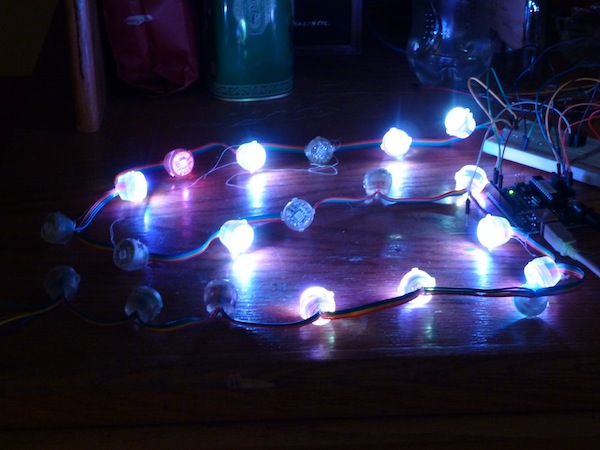
These vividly colored icosahedrons look great when hung from the ceiling, or a wall, but the fun doesn't stop there. You'll notice that the colors seem to follow a pattern which is quite amazing.
I'll skip over the cool math that is involved, but try holding two opposite nodes still, and spin it by 1/5 of a rotation. What happens to all the yellows? All the greens? etc. Maybe I'll make a video about it later!
My icosahedrons are made using colored skewers that are held together with wire. It is not glued, but the whole thing is dipped in acrylic medium to give it a nice shiny finish. They are very durable and can be kicked around the house without breaking (don't try too hard though, ok?)
I will sell this by dutch auction, starting at $150, and reducing by $5 each week. You never know who's waiting for it to come down, so buy it quick!
http://www.etsy.com/listing/84895025/beautiful-geometric-sculpture-with
This is a "Hexastix", shaped into a "Stellated Rhombic Dodecahedron". It casts a beautiful shadow, and belongs in a sunny window where the light hits something behind it. You'll need to remember that if you buy it. :)
I make all of my sculptures in a small rented workshop in Victoria, BC, where I am a PhD candidate at the University of Victoria.
Beauty in mathematics, especially geometric beauty, is an ongoing passion. The asking price of this sculpture is very low, but it is worth selling, just to know someone else is in love with it.
Learn more about GeoBurst on http://geoburst.ca

I am pleased to announce the publication Japanese tatami mat tilings: No four tiles meet, in the Notes from the Margin, Volume II, 2011, from the Student Committee of the Canadian Mathematical Society.
The title of the newsletter comes from the story behind Fermat's last theorem. He had written in the margins of his notebook:
it is impossible to separate a cube into two cubes, or a fourth power into two fourth powers, or in general, any power higher than the second, into two like powers. I have discovered a truly marvelous proof of this, which this margin is too narrow to contain. (wikipedia)
This article is a condensed version of a result in the conference proceedings: A. Erickson, M. Schurch, 2011: Enumerating tatami mat arrangements of square grids, in 22nd International Workshop on Combinatorial Algorithms, University of Victoria, June 20-22, volume 7056 of Lecture Notes in Computer Science (LNCS), Springer Berlin / Heidelberg, 2011, p. 12 pages.
Abstract:
Tatami mats are the type of mats used in traditional Japanese rooms. Often, an arrangement in which four mats meet at a point is considered unlucky, perhaps because the word “four” sounds like the word “death” in Japanese. So, a “lucky” layout has no “+” shapes formed by the lines where mats meet. Compare the following two arrangements.
Tatami tilings are accessible and fun, so go ahead and take a gander!
You'll no longer be sitting beside that sexy marine biologist dressed up as a sea anemone wishing that you could have a research themed costume too.
Finally, there is a combinatorics themed halloween costume! Sport this beautiful Arduino and LED based rendition of Cool-lex combinations (research by Aaron Williams and Frank Ruskey), and show off your nerd times 2.
Here is the technical stuff on the combinations:
http://webhome.cs.uvic.ca/~ruskey/Publications/Coollex/Coollex.html
I used adafruit's LDP6803 LEDs. There are tutorials on how to use them on that page.

This week I had the pleasure of teaching a Hexastix workshop to a group of volunteer mathematics educators, at the invitation of the 2011 PIMS Education Prize winner, Veselin Jungic. As with my previous experience teaching Hexastix at Math Camp, these beautiful mathematical objects will be the take-home project for students participating in Small Number, a program for First Nations math education.

Small Number is not precisely the name of the program, but of the protagonist in the associated animation, which is narrated in Blackfoot, Cree, and English on YouTube (embedded below). If you have never heard Blackfoot or Cree, I strongly suggest you listen to those versions. The languages are moving and sounds fascinating. Here is a language map, just to give you an idea of how many First Nations languages there are in British Columbia (I’m as amazed as you are!).
The animation and the school workshop program are products of several meetings at the Banff International Research Station beginning in November 2006. There, First Nations communities have partnered with math educators to assess the performance of First Nations students in mathematics, and to find ways of providing them with more opportunities to learn it. The data presented at the workshop shows, for example, that “Over the last seven years, only 5-7 percent of Aboriginal students have written and passed the Principles of Mathematics 12 provincial exam, compared to 25-27 percent of non-Aboriginal students.”
My part is to provide the program with 15,000 coloured sticks, as well as other materials, and teach their volunteers how to make Hexastix. I used my blog post about it as a visual guide to my workshop. The volunteers were challenged, and they enjoyed themselves. Here are some pictures of our workshop.
My first real math course - real analysis, in my case - was given by Dr. Jungic in 2004. His other students and I like to recall how he explained infinitesimals by saying “small small small small”, and motioning with his hands, and then he would describe large numbers by saying “HUGE” and throwing up his hands.
